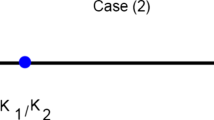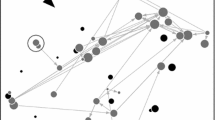Abstract
One of the fundamental goals of ecology is to examine how dispersal affects the distribution and dynamics of insects across natural landscapes. These landscapes are frequently divided into patches of habitat embedded in a matrix of several non-habitat regions, and dispersal behavior could vary within each landscape element as well as the edges between elements. Reaction–diffusion models are a common way of modeling dispersal and species interactions in such landscapes, but to apply these models we also need methods of estimating the diffusion rate and any edge behavior parameters. In this paper, we present a method of estimating the diffusion rate using the mean occupancy time for a circular region. We also use mean occupancy time to estimate a parameter (the crossing probability) that governs one type of edge behavior often used in these models, a biased random walk. These new methods have some advantages over other methods of estimating these parameters, including reduced computational cost and ease of use in the field. They also provide a method of estimating the diffusion rate for a particular location in space, compared to existing methods that represent averages over large areas. We further examine the statistical properties of the new method through simulation, and discuss how mean occupancy time could be estimated in field experiments.
Similar content being viewed by others
References
Cain ML (1990) Models of clonal growth in Solidago altissima. J Ecol 78: 27–46
Cantrell RS, Cosner C (2003) Spatial ecology via reaction–diffusion equations. Wiley, Chichester
Cronin JT (2007) From population sources to sieves: the matrix alters host-parasitoid source-sink structure. Ecology 88: 2966–2976
Cronin JT, Haynes KJ (2004) An invasive plant promotes unstable host-parasitoid patch dynamics. Ecology 85: 2772–2782
Cronin JT, Reeve JD, Wilkens R, Turchin P (2000) The pattern and range of movement of a checkered-beetle predator relative to its bark-beetle prey. Oikos 90: 127–138
Fagan WF (1997) Introducing a “boundary-flux” approach to quantifying insect diffusion rates. Ecology 78: 579–587
Haynes KJ, Cronin JT (2003) Matrix composition affects the spatial ecology of a prairie planthopper. Ecology 84: 2856–2866
Haynes KJ, Cronin JT (2006) Interpatch movement and edge effects: the role of behavioral responses to the landscape matrix. Oikos 113: 43–54
Kareiva P, Odell G (1987) Swarms of predators exhibit “preytaxis” if individual predators use area-restricted search. Am Nat 130: 233–270
Kolmogorov A, Petrovskii I, Piscounov N (1991) A study of the diffusion equation with increase in the amount of substance, and its application to a biological problem. In: Tikhomirov VM (ed) Selected Works of A. N. Kolmogorov I. Kluwer, Dordrecht, pp 248–270
Lawrence WS, Bach CE (1989) Chrysomelid beetle movements in relation to host-plant size and surrounding non-host vegetation. Ecology 70: 1679–1690
Manly BFJ (1997) Randomization, bootstrap and Monte Carlo methods in biology. Chapman & Hall, New York
Min A, Cronin JT, Reeve JD, Xiao M, Xu D (2012) Identification of diffusion coefficient and returning probability in nonhomogeneous landscapes (preprint)
Mood AM, Graybill FA, Boes DC (1974) Introduction to the theory of statistics, 3rd edn. McGraw-Hill, New York
Okubo A, Levin SA (2001) Diffusion and ecological problems: modern perspectives, 2nd edn. Springer, New York
Ovaskainen O (2004) Habitat-specific movement parameters estimated using mark-recapture data and a diffusion model. Ecology 85: 242–257
Ovaskainen O, Cornell SJ (2003) Biased movement at a boundary and conditional occupancy times for diffusion processes. J Appl Probab 40: 557–580
Pinsky MA (1998) Partial differential equations and boundary-value problems with applications. American Mathematical Society, Providence
Reeve JD, Haynes KJ, Cronin JT (2008) Diffusion models for herbivore movement incorporating heterogeneity among substrates, individuals and edge behaviors. J Anim Ecol 77: 898–904
Reeve JD, Cronin JT (2010) Edge behavior in a minute parasitic wasp. J Anim Ecol 79: 483–490
Ricketts TH (2001) The matrix matters: effective isolation in fragmented landscapes. Am Nat 158: 87–99
Ries L, Debinski DM (2001) Butterfly responses to habitat edges in highly fragmented prairies of central Iowa. J Anim Ecol 70: 840–852
Roland J, Keyghobadi N, Fownes S (2000) Alpine Parnassius butterfly dispersal: effects of landscape and population size. Ecology 81: 1642–1653
Sharon E, Mumford D (2007) 2D-shape analysis using conformal mapping. Int J Comput Vis 70(1): 55–75
Turchin P (1998) Quantitative analysis of movement: measuring and modeling population redistribution in plants and animals. Sinauer Associates, Sunderland
Author information
Authors and Affiliations
Corresponding author
Additional information
This research was supported by NSF DEB 0515781, 1021203 and DMS 0719783.
Rights and permissions
About this article
Cite this article
Xiao, M., Reeve, J.D., Xu, D. et al. Estimation of the diffusion rate and crossing probability for biased edge movement between two different types of habitat. J. Math. Biol. 67, 535–567 (2013). https://doi.org/10.1007/s00285-012-0561-6
Received:
Revised:
Published:
Issue Date:
DOI: https://doi.org/10.1007/s00285-012-0561-6




